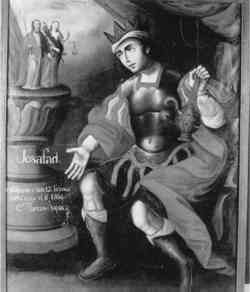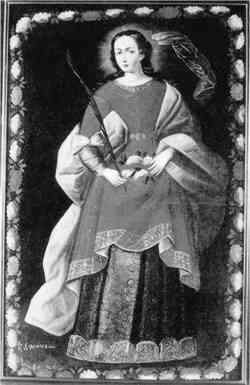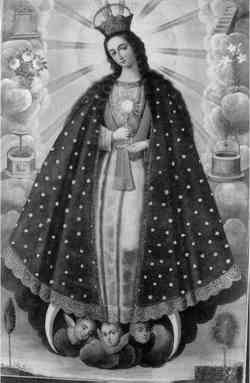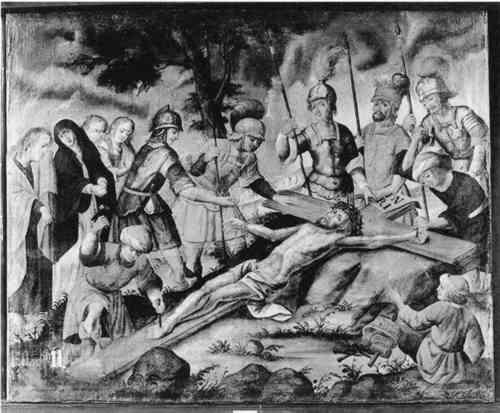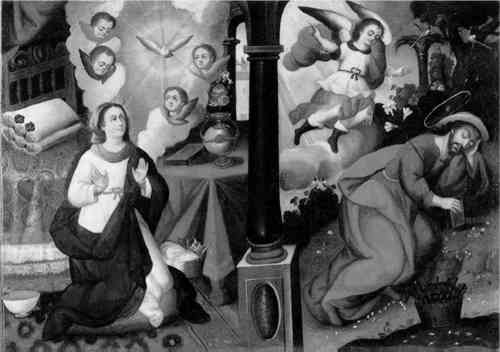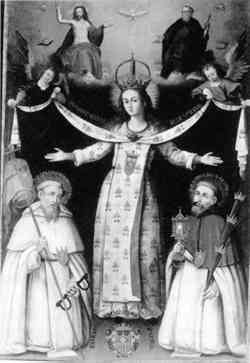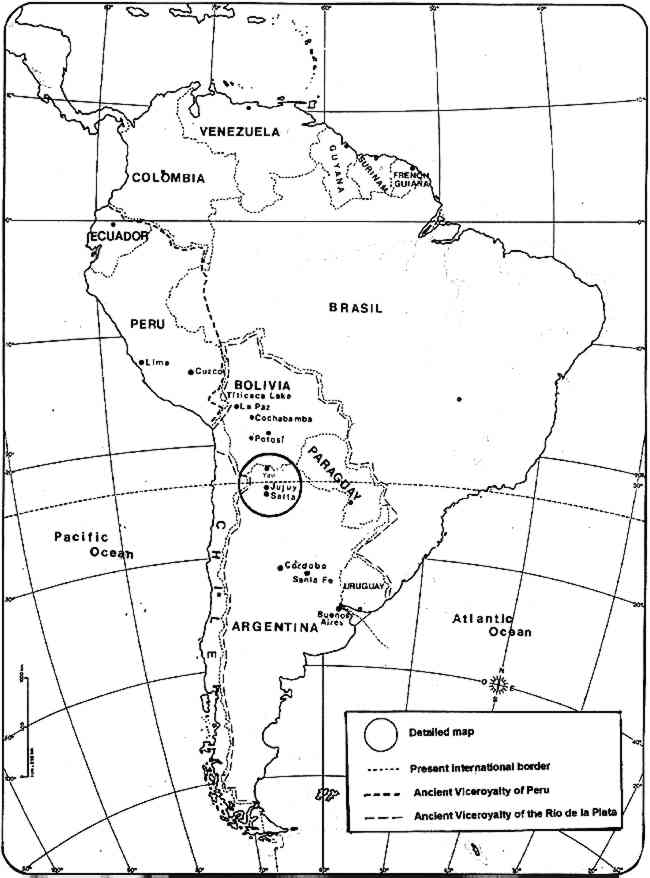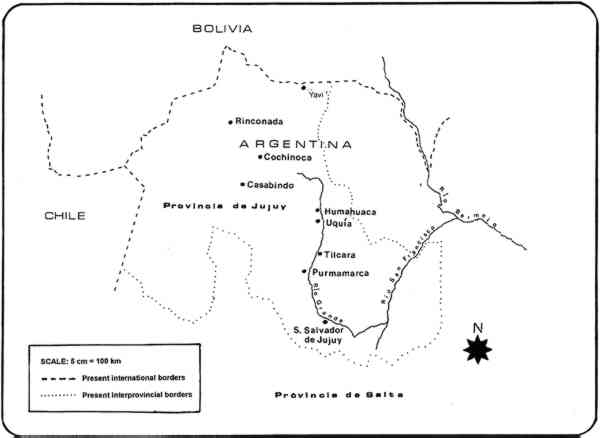BLUE PIGMENTS IN SOUTH AMERICAN PAINTING (1610–1780)ALICIA M. SELDES, JOS� EMILIO BURUC�A, MARTA S. MAIER, GONZALO ABAD, ANDREA J�UREGUI, & GABRIELA SIRACUSANO
ABSTRACT—This article shows the results reached by an interdisciplinary team of chemists and art historians following studies of the use of blue pigments in a group of 106 paintings done in the Andes region during the colonial period (1610–1780). It describes the methods employed and the results obtained in the analysis of these pigments, along with important observations on the historical dimension of the practices developed by South American artists of that period. TITRE—L'Utilisation des Pigments de Couleur Bleue dans la Peinture Sud-Am�ricaine (entre 1610 et 1780). R�SUM�—Cet article pr�sente les r�sultats du travail d'une �quipe interdisciplinaire compos�e de chimistes et historiens de l'art de la Fondation Tarea et de l'Universit� de Buenos Aires, concernant une �tude des pigments de couleur bleue dans un groupe de 106 tableaux peints dans la r�gion des Andes durant la p�riode coloniale (1610–1780). On y d�crit les m�thodes employ�es et les r�sultats obtenus lors de l'analyse de ces pigments, ainsi que d'importantes remarques sur la dimension historique des pratiques d�velopp�es par les artistes sud-am�ricains de cette p�riode. TITULO—Los pigmentos azules en la pintura sudamericana (1610–1780). RESUMEN—Este art�culo describe los resultados logrados por un equipo interdisciplinario—qu�micos e historiadores de arte de la Fundaci�n Tarea y de la Universidad de Buenos Aires—en los estudios del uso de pigmentos azules en un grupo de 106 cuadros pintados en la regi�n de los Andes durante el per�odo colonial (1610–1780). Se describen los m�todos empleados y los resultados obtenidos en el an�lisis de estos pigmentos, junto con importantes consideraciones sobre la dimensi�n de las pr�cticas desarrolladas por los artistas sudamericanos de ese per�odo. 1 PAINTING IN THE ANDES: HISTORICAL BACKGROUNDThree Italian artists introduced the European manner to the viceroyalty of Peru in the 17th century: Mateo da Lecce (known as Mateo P�rez de Alesio), Angelino Medoro, and Bernardo Bitti, all of whom were trained in the great Italian workshops of the High Renaissance. Bitti worked in the Cuzco region during the first years of the 17th century and left some disciples, including Pedro de Vargas and Gregorio Gamarra. Although P�rez de Alesio and Medoro painted almost all their works in Lima, Perez's influence seems to have spread throughout the Peruvian territory, including Cuzco, by means of the drawings and copies of engravings produced in his workshop. Medoro's style reached the ancient Inca capital when Luis de Ria�o, one of his pupils, settled there. Until 1650, Cuzco painting followed the manner of the High Renaissance: monumental and enlarged figures dressed in voluminous clothes, presented either in small groups on neutral backgrounds or in large, crowded scenes that cover almost the entire canvas. Engravings of complex sacred allegories and emblems, produced in the Flemish, French, or Italian workshops, spread throughout the Americas to support the propaganda of the church of the Counterreformation. These models inspired the approaches to landscape, urban scenes, perspective, and architectural interiors among Andean painters. The palette, limited to ochre, yellow, blue, and intense red, became increasingly complex and was enriched by the use of gold to re-create the luster of jewels and the rich and varied textures of cloth. The preferred themes of the patrons—mostly bishops and religious orders—were the lives of the saints presented in series of 20 or more detailed paintings describing episodes of During the 18th century, the artists of the Cuzco school continued in the tradition of the preceding baroque era. Large workshops, directed by such renowned masters as Basilio Pacheco and Marcos Zapata, produced series of paintings in an almost industrial way, with specialized artists for every phase of the execution (one for the faces and hands and others for flower decorations, landscapes, and details). The huge number of paintings thus produced were delivered throughout a large territory, including major cities and smaller villages in Argentina and Chile. 2 RESEARCH BACKGROUNDFor several years the restoration workshop of the Fundaci�n Tarea, Buenos Aires, has been involved in the preservation, chemical analysis, and historical and iconographic study of paintings from the Spanish colonial period now found in the churches, chapels, and museums of Argentina. The paintings vary in quality of execution, chronology and—of greatest interest here—origin. Among them are canvases that undoubtedly come from 18th-century Cuzco workshops, works produced by the P�rez Holgu�n circle in Potos�, and paintings done on the Puna plateau of northwestern Argentina or in the province of C�rdoba. The present study centers on a group of 106 works (see appendix), painted between 1610 and 1780, which are now found in the following locations: churches and chapels of the Argentine northwest, province of Jujuy; the Marqu�s de Sobremonte Provincial Historical Museum, C�rdoba; the Julio Marc Provincial Historical Museum, Rosario, province of Santa Fe; the Isaac Fern�ndez Blanco Municipal Art Museum, Buenos Aires; and the Casa de la Cultura E. y F. Burgos, Mendoza. This article describes the methods and results of the analysis of the blue pigments present in each painting selected. The Fundaci�n Tarea's study is the first of its kind for South American colonial painting. Both qualitative and quantitative methods were used. First, chemical microscopy was carried out on cross sections or on unmounted samples. The specific microchemical tests used for each pigment are described in the section corresponding to the pigment. Scanning electron microscopy energy dispersive x-ray spectrometry (SEM-EDS) was also used to confirm the presence or absence of the suspected elements of each pigment. Polarized light microscopy was used only for the analysis of the azurite and smalt mixture. There have been several complete scientific studies of pigments and binders used in Mexican painting, especially during the pre-Columbian period (Carrillo y Gariel 1946). Since 1995, the Fundaci�n Tarea's effort has been augmented by a team of professors and researchers—chemists and art historians—from the University of Buenos Aires, which has made two important grants for scientific advances in the restoration and identification of artworks in the Argentine national patrimony. The study of blue pigments quickly proved to be a suitable field for systematic analysis, promising substantial findings, because the identification of these pigments' origin and manner of production has always presented complex problems that have conditioned aesthetic judgment and historical assessment. In the canvases studied, the blues show obvious disparities in brilliance and saturation from one work to another, suggesting the presence of different pigments. The limited bibliography in existence until a few years ago indicated, without much basis in known chemical testing, the South American artists had used indigo (a blue of vegetable origin), azurite (a copper mineral), and, occasionally, ultramarine. Querejazu (1986) mentions Castilian blue (presumably ultramarine), a�il or indigo from Central America, polvos azules (blue powders), and azurite. This article considers the last two 3 RESULTSOur research has brought to light examples of the following blue pigments: indigo, azurite, smalt, and Prussian blue. We found them employed in three ways:
In each category, we grouped the pieces according to their origin (either certified or attributed with a high degree of probability). We identified the artists, either documented or proposed as a result of indicative attribution techniques (overall style, details of execution in the faces, hair, hands and clothing, etc.), and the dates of execution, both documented and probable. Within each subgroup of origin, the order of presentation is chronological beginning with the oldest work. (See appendix.) 4 BLUE PIGMENTS EMPLOYED SINGLY AND EXCLUSIVELY: INDIVIDUAL PAINTINGS AND THEMATICAL SERIES4.1 INDIGONatural indigo is an organic blue dye obtained from plants of the family Papilionaceae(Schweppe 1997). Due to its color and its fine granules, this dark blue powder may be easily confused with Prussian blue in paints. To distinguish them, reactions with 4N sodium hydroxide (4N NaOH) and with concentrated nitric acid (HNO3) were performed in all cases. In the first case, indigo remained unchanged, while Prussian blue went into solution to produce Indigo was used in 64 of the paintings studied. Table 1 lists the samples analyzed. Note that of the 64 paintings in which indigo was used, all but one were probably painted in Cuzco (see fig. 1 and appendix). TABLE 1. PAINTINGS WITH INDIGO AS SOLE BLUE PIGMENT
The vegetable dye indigo, also called a�il in Portugal and Spain, was produced in Guatemala in colonial times, according to the testimony of Antonio de Le�n Pinelo dated 1653 (Le�n Pinelo 1943, 249). There it was distributed in the Americas and Spain. Two 17th-century sources—the History of the New World, written in 1653 by the Spanish Jesuit Bernab� Cobo, and an anonymous manuscript, surely written by a converted Portuguese Jew, a subject of the ruling lords of Holland—credit the Central American origin of the a�il that was consumed in Peru: “Blocks [piedras] of all colors for paint are to be found in many places, such as a�il in chunk form [en piedra], very fine green, blue and all colors” (Cobo [1653] 1890, 289). “Also brought [to Lima]; … a�il and cochineal from the provinces of Guatemala and Nicaragua. … The City of Kings [Lima] has navigation for all the coast of Nicaragua, Guatemala and Sonsonate, and others. The ships go out with wine and return to Peru loaded with tar and tobacco and cochineal and a�il. … Some frigates also come here from Lake Maracaibo, loaded with flour and other cargo of a�il and cochineal” (Lewin 1958, 114). The presence of Indigofera growing in the territory of the Yucarar�, Siriono, Yunga, and Mache in the high jungle east of La Paz was documented late in the 18th century by the Czech naturalist T. Haenke (1898), a member of the Malaspina expedition, but there is no information as to whether any a�il made from it was used as a pigment by painters. A. Carrillo y Gariel (1946, 27) affirms that Indigofera a�il L. was grown in New Spain and that the Native Americans used the product as a pigment. He adds the comments of an English traveler, Robert Thomson, and a paragraph from Father Land�var's Rusticatio Mexicana, both of which specify different ways of curing the a�il exported from Guatemala. Among the classic Spanish writers on painting, V. Carducho ([1633] 1979)
Antonio Palomino, in 1723, accepts the inclusion of a�il for “working up” (labrar), that is, for developing the chiaroscuro and the details of blue surfaces (Palomino [1723] 1988, 156). The modes of curing a�il proposed by the Spanish and the way of using it in mixtures with other pigments were reviewed by Manuel de Samaniego of Quito at the end of the 18th century in his Tratado de Pintura. All these authors believed that it was preferable to use indigo to paint things considered “of lesser importance,” saving other, finer blue pigments for more important works (Vargas [1944] 1975, 96). 4.2 AZURITEAzurite is a pigment of mineral origin composed of a basic copper carbonate, 2CuCO3�Cu(OH)2(Gettens and FitzHugh 1993). Among the analytical criteria used for the identification of azurite are solubility and effervescence in cold 3N hydrochloric acid (3N HCl) and in concentrated HNO3(Gettens and FitzHugh 1993), performed on the cross sections. A test for copper in azurite using rubeanic acid (Plesters 1956) was performed on the samples, along with a test for the solubility in ammonia, to afford a deep blue solution of copper ammonia complex. SEM elemental analysis indicated in all cases the presence of copper as a sole component or sometimes with minor impurities, such as lead, silicon, calcium, aluminum, or iron. Azurite was found to have been used singly in five of the paintings in this study (see appendix). Seven samples were analyzed (table 2). TABLE 2. PAINTINGS WITH AZURITE AS SOLE BLUE PIGMENT Azurite is a pigment of mineral origin. It is obtained from a semiprecious stone similar to malachite, composed of carbonate of copper, whose use was registered by Pliny in the first century A.D. Ground into powder, it was used in tempera, in fresco painting, and with oil; in oil it often turns green, and for this reason Renaissance and baroque authors wrote at length about how to avoid this result. Pacheco and Palomino refer to this pigment as “fine blue or Santo Domingo blue” (Pacheco [1649] 1866, 80–82) and as “fine, thin blues of ashes” (azules de cenizas finas y delgadas) (Palomino [1723] 1988, 561), noting that the Spanish painters used it instead of ultramarine or lapis The archaeologist H. Yacobaccio (1995), among others, has shown that azurite was known and appreciated during pre-Hispanic times in what is now the Argentine Northwest. He found beads of this mineral, of a splendid blue color, in a burial dated A.D. 900 in Casabindo, Jujuy. It is known that azurite was mined from that time until the 16th century from Sapo Peak in Bolivia, department of Cochabamba, and in copper deposits on the Puna de Atacama. Le�n Pinelo recorded the existence of a mine from which “blue powder for painters” was obtained as late as the mid-17th century; it was located “in the province of the Chicha people, where it borders on that of Atacama near the town of Caspana, a mine worked by the Incas, although by now it yields little, being very deep” (Le�n Pinelo 1943, 266). Given that pre-Hispanic rock painting with traces of azurite has been found in Caspana, near the upper Loa River northeast of San Pedro de Atacama, it seems probable that the deposit described by Le�n Pinelo would have been of this mineral. He also mentions a “blue powder” that was extracted mainly from Santo Domingo, Hispaniola, which reinforces our 4.3 SMALTSmalt is an inorganic pigment of complex manufacture. It is a potassium glass of blue color due to the addition of small, variable amounts of cobalt. Its composition may vary considerably depending on the sources from which it was obtained (M�hlethaler and Thissen 1993). It is not a definite chemical compound. Besides its usual composition—SiO2 (66–72%), K2O (10–21%), CoO (2–18%), As2O3 (0–8%)—it might contain impurities such as oxides of barium, calcium, sodium, magnesium, nickel, iron, copper, and manganese (Winckler [1790] 1959). Microchemical methods were used on all the cross sections to evaluate the presence of smalt, including insolubility tests in cold 3N HCl, concentrated HNO3, and 4N NaOH (Plesters 1956). A spot test with rubeanic acid (Plesters 1956) was also carried out on all the samples. In addition, smalt was positively identified in all cases by SEM-EDS analysis. The presence of silicon, potassium, and cobalt in the expected percentages as main components allowed its identification, beyond minor amounts of different impurities such as iron, calcium, lead, arsenic, magnesium, aluminum, and sulfur. Smalt was used in 17 paintings (see appendix). Table 3 and figure 3 provide examples.
TABLE 3. PAINTINGS WITH SMALT AS SOLE BLUE PIGMENT Smalt is a synthetic material, and there is no record of its having been produced in the Americas before the second half of the 19th century (Bargall� 1955). The procedure for manufacturing smalt is as follows. Zaffer or zaffree, a cobalt oxide obtained laboriously by heating and pulverizing the mineral, is poured on a mass of molten glass, which acquires a blue color and is in turn immersed in cold water where it divides into granules. These granules are later ground fine to produce the smalt pigment. The color thus obtained probably was used in Europe in the 16th century, and there is no doubt that the technique of preparing zaffer from cobalt mineral was known at that time by metalworkers, glassworkers, and ceramists. In De subtilitate, a treatise full of magical fantasies and marvels but also of inventions and discoveries in optics, mechanics, and chemistry, Cardano refers to zaphera, “an earth that stains glass blue” (Neri et al. 1752, 49). The naturalist Ulisse Aldrovandi also speaks of it sometimes calling it an “earth” and others as a “stone” (Neri et al. 1752, 49). Scaligero, who wrote a treatise on glass, seems not to have known about zaffer (Neri et al. 1752, 47). In De re metalica Agricola did not call the pigment by that name, but he was the first to name it cobaltum or cadmia fossilis (Neri et al. 1752, 47). Only toward the end of the 17th century did chemists realize that cobalt, not copper, was the fundamental base of zaffer. Until then, no one had noticed that Agricola had provided accurate news about zaffer (Neri et al. 1752, 47). Despite Scaligero's contribution, the first treatise on the art of glassmaking to be known throughout Europe was L'arte vetraria by the Florentine priest Antonio Neri ([1612] 1678). It was published in Italian in 1612, translated into several languages and reedited on numerous occasions during the 17th century. In book 6, Neri reviews the processes for making smalt for glassmakers and goldsmiths and pays high tribute to zaffera in giving recipes for obtaining turchino and azzurro(Neri [1612] 1678, 147]. In 1669, a Latin edition of Neri's book was published in Amsterdam, surely increasing its potential circulation. In fact, an English edition of L'arte had already been published in 1667, with erudite comments by Christopher Merret1, the learned physician and alchemist, founding member of the Royal Society. This work must have been one of the first publications brought out by the society, only two years after it was founded. In his note on zaffer,
We have taken Merret's notes from a French edition of Neri and his commentators, Art de la Verrerie, dated in Paris 1752, and translated from the 1679 German edition by Baron D'Holbach himself. Merret also stated that the name zaffer came from “sapphire,” whose blue color it imitated. A few years later, in 1679, the famous German chemist Johann Kunckel2, published in Frankfurt and Leipzig a German translation of Neri's text with Merret's notes, adding some comments of his own. Kunckel identified cobalt, a metal different from copper, as the basic element of zaffer and explained the procedure for obtaining the paste or powder of zaffer from the raw mineral through calcination and evaporation of the arsenic that is present in the natural mixture as mined from the deposit. Kunckel stressed that Saxony was the European country where the best zaffer was obtained and manufactured, and he pointed out that the prince electro of Saxony was on his way to controlling zaffer production and trade worldwide (Neri et al. 1752, 51). In effect, during the 18th century Saxony held a monopoly on the pigment, and it is highly probable that its mines and manufactures produced the smalt that Spanish and South American painters used from the late 17th century. Semanario econ�mico, a Spanish scientific and technological publication published between 1765 and 1767 in Madrid, included “the way to make zaffer, or blue smalt color as it is done in Saxony” among its “practical, curious and erudite information” about agriculture, painting, ceramics, glass-making, silverwork, brasswork, bread- and pastry-making, enameling, engraving, the uses of mercury, and manufacture of Chinese porcelain (Tandeter 1995). Among the Spanish authorities on painting, Pacheco gives his personal recipe for making blue cloth look like ultramarine: smalt mixed with linseed oil and lavender. A�il, when mixed with smalt, acquires more body and spreads better, making it good for sketching, says Palomino ([1723] 1988, 156), although for depicting cloth only “fine white smalt” should be used, “mixed with walnut oil and turpentine”; “the easiest way of working it up is to bathe all the sketched cloth with straight smalt, easing [diluting] it with walnut oil and turpentine, and then work up the cloth, tighten the dark spots with pure a�il” (Palomino [1723] 1988, 141). Smalt was much appreciated for oil painting because of the drying properties of cobalt, which made it ideal for mixing with other blue pigments that were slower to dry: “[a�il], in order to dry, needs a little fine-ground smalt, or ground glass, as a drying agent, as I have said, or walnut oil, or a dash of Paris green, which I prefer” (Palomino [1723] 1988, 157–58). Samaniego seems to follow Palomino literally when he recommends that in order to depict
Chemical analyses performed during the restoration of an Immaculate Conception (1680) by the Spanish painter Francisco Rizi in the convent of the Gaitanas in Toledo revealed that in representing the Virgin's cloak, the artist had made masterful use of several layers of smalt, alone or mixed with vermilion to achieve a violet hue. As Tomkiewicz (1995) indicates, the use of smalt has been identified in the present Smalt had to be imported from Europe, while indigo was produced in the Americas, and azurite was known and used in South America from pre-Hispanic times. It is quite possible that Saxony provided smalt through Spanish dealers, meaning a long journey for the vitreous blue pigment from the heart of Germany to the Puna plateau. The matter of how that color reached the South American painters—as prepared smalt, or as smalt for the use of silversmiths, or in some other form—will remain an open question. Yacobaccio (1995) studied a Native American burial in Casabindo, Jujuy, from the 17th century, in which blue crystal beads from Bohemia were present. If we consider that the Bohemian glass industry used zaffer from Saxony to dye the crystals blue, it may well be that the painters of the Puna—Pisarro and his assistants, in this case—ground those beads to obtain a powder that they then used with oil in their paintings, as occurs in the smalt manufacture process described in the references mentioned in this article (Seldes 1994). Our chemical analysis has detected a cobalt compound that is the basis of zaffer and smalt, and the electron microscope has made it possible to see glass particles in the corresponding layers of blue pigment. Both results would fit genuine smalt or a powder obtained by grinding up Bohemian crystal. The anonymous 17th-century Portuguese chronicler refers to the import to Lima of glass beads of various colors, which lends some strength to our hypothesis. He also mentions smalts for silversmiths
4.4 PRUSSIAN BLUEPrussian blue is a hydrated iron hexacyanoferrate complex, Fe4[Fe(CN)6]3. Sometimes the chemical formula also contains sodium, ammonium, and/or potassium (Berrie 1997). Optical as well as chemical microscopy, as described for indigo, allowed differentiation of both pigments. The extreme sensitivity of Prussian blue to alkali and the reformation of the blue color with acid provides confirmation of its presence. The presence of iron in the basic solution was also confirmed by the formation of red color on addition of ammonium thiocyanate. SEM elemental analysis confirmed the presence of Prussian blue due to the presence of iron. Prussian blue was found to have been used in 17 paintings (see appendix). Table 4 and figure 5 provide examples.
TABLE 4. PAINTINGS WITH PRUSSIAN BLUE AS SOLE BLUE PIGMENT The manufacturing process of Prussian blue was discovered by Ghislain Diesbach in Berlin in 1704. Around 1724 it was introduced as a pigment for painters, which explains the fact that Palomino did not include it in his treatise published the year before (Palomino [1723] 1988). It met with quick and extraordinary success; by the mid-18th century it was being used in oil painting all over Europe. There are documentary records of the use of Prussian blue in South America by 1790 (Aguirre Saravia 1967), a date that corresponds with the inclusion of the pigment in the Tratado de pintura by Manuel de Samaniego of Quito. It does not seem to have been used frequently, since Samaniego, speaking of mixtures for depicting purple cloth, advises using “carmine-blue powders, because a�il is no good; if you have Prussian blue it will do better.” He recommends it for landscapes: “for the countryside at sunrise, … light blue, not a�il, nor powders, Prussian blue will be best for this” (Vargas [1944] 1975; 96–98). In this context, our attention is drawn to the affirmation that the layer of paint in the 10 canvases of the Angels of Calamarca series indicates the presence of Prussian blue (Rua 1993, 18). Rua accepts the traditional dating of this series in the last third of the 17th century, proposed by Mesa and Gisbert (1977) on the basis of stylistic criteria that would link it to the circle of the painter Jose L�pez de los R�os, active in Carabuco in 1684. The date would seem not to be after 1728, when the presence of 36 canvases depicting archangels and angels was 4.5 BLUE PIGMENTS COMBINED IN DIFFERENT LAYERS OF PAINTThe combination of two blue pigments in separate layers of paint was positively identified in one sample in this study (table 5). Figure 2 combines indigo and azurite in separate layers. Figure 4 combines indigo and Prussian blue in separate layers. The analytical techniques used to positively identify each type of blue in different layers of paint were the same as those described for azurite and for smalt.
TABLE 5. PAINTINGS WITH AZURITE AND SMALT IN SEPARATE LAYERS TABLE 6. PAINTING WITH AZURITE AND SMALT IN THE SAME LAYER 5 BLUE PIGMENTS MIXED ON THE PALETTE BEFORE SPREADING IN A SINGLE LAYER OF PAINTThe presence of both azurite and smalt as a mixture in a single layer was determined by different methods. Chemical microscopy carried out on the cross section, using the tests described previously for smalt and for azurite, did not produce reliable results. SEM elemental analysis allowed the identification of only the larger crystals of each pigment, and the results were the same obtained for the individual components as described earlier. Polarized light microscopy of the sample mounted in Canada balsam resulted in an extremely useful technique for identifying the particles of each pigment. Between crossed polars under the microscope, the smalt particles appeared dark and quite different from the blue azurite particles. Pacheco ([1649] 1866, 107) says of this mixture:
6 CONCLUSIONSIndigo and Prussian blue, the latter not before 1770, seem to have been the blue pigments most employed in the workshops of Cuzco in the 18th century. Note that Prussian blue, discovered in Europe in 1704 and spread through the Old World in the 1720s, has not been registered until now in any Cuzco work dated clearly before 1770. This finding coincides approximately with our oldest documented record of this pigment in South America in 1789. The use of azurite is noteworthy in the city of C�rdoba at the beginning of the 17th century. The grinding of azurite used in paintings dating since the end of the 17th century appears to be a quite different process, probably of Central or South American origin. This pigment, probably local, appears in three works attributed to Mateo Pisarro and his workshop, installed in the estate of the Marqu�s del Valle de Tojo on the Puna de Smalt was widely used by Pisarro and his assistants. Smalt is also recorded in works coming from P�rez Holgu�n's workshop in Potos� (dating from the late 17th and early 18th centuries). Thus it is possible to entertain the hypothesis (also supported in shared subtleties of pictorial execution) that there was perhaps a teacher-student relationship between P�rez Holgu�n and Pisarro; the latter is known to have passed through Potos� in 1691 (Academia Nacional de Bellas Artes 1991, 11). Only three paintings originating in Cuzco and painted in the 18th century reveal smalt in the blues. The combination of pigments in different layers of paint rarely occurs on the same canvas. This technique is clearly established only in an unusual piece from Cuzco (exceptional for the iconography of a Circumcision located on the rock of Nativity rather than in the Temple), painted perhaps in the 17th century. In this painting we found azurite and smalt in different sectors of the canvas. However, as noted in the appendix, there are some indications of a possible use of indigo and azurite in successive layers (Cuzco, first half of the 18th century), or indigo and smalt (Puna, first half of the 18th century), or indigo and Prussian blue (Cuzco, second half of the 18th century). If this is true, it might be inferred that the ideas of Spanish authors such as Pacheco and Palomino, who recommended the use of several pigments in different phases of the work with color, had been known in the workshops of South America. Evidence is found in the writing of Manuel de Samaniego of Quito, who in the late 18th and early 19th centuries took the technical definitions from classic Spanish writers on art and added information drawn from his own experience with Prussian blue. A single case among the 106 studied—Our Lady of Mercy, with
This group of paintings as a whole reveals the broad knowledge and great experimental and inventive capacity of South American artists in the matter of pigments. They had to solve the aesthetic problems that arose in the appropriation and reworking of European models that almost always reached them in black and white. This challenge is reflected in Samaniego's Tratado de la pintura, first published in 1944 (Vargas [1944] 1975). Properly speaking, it seems to be more of a personal notebook for use in the author's practice of painting and in his teaching rather than a treatise; it contains summaries of fragments drawn from the Spanish authorities. It is significant that the most original parts of his work are his advice and recipes for depicting the flesh of the figures and his notes on making colors derived from his own experience as a painter. All this helps us to understand and appreciate the practice of those who, like Pisarro, working at a great distance from urban centers such as Cuzco, Potos�, or C�rdoba, were able to display invention and originality in the employment and mixture of pigments. ACKNOWLEDGEMENTSThis work was performed with paintings being restored at Fundaci�n Tarea, Buenos Aires, Argentina. We want to thank the staff of Fundaci�n Tarea for their collaboration and Gonzalo J. Flank for drawing the maps that appear in the appendix(figs. 7–8). Financial support was provided by Fundaci�n Antorchas, CONICET, and Universidad de Buenos Aires.
NOTES. Merret was born in 1614 and died in London in 1695. In 1642 he received the degree of doctor of medicine at Oxford University. His most famous works were the annotated Neri and a vast naturalist's compilation, including 1,400 plants of Great Britain, ordered alphabetically, collected with the help of the nomadic herbalist Thomas Willisel. We have taken Merret's notes from a French edition of Neri and his commentators, Art de la Verrerie, dated in Paris, 1752, translated from the 1679 German edition by Baron D'Holbach himself. . Johann Kunckel was born in Rendsburg in 1630 and died in Stockholm in 1702. His father had been alchemist to the duke of Holstein. Kunckel was pharmacist and chemist to the dukes of Lauenburg. He later went into the service of the elector of Saxony and there became familiar with the manufacture of zaffer. In 1679, Frederick William of Brandenburg called him to Berlin to direct his glass factories and laboratories. In 1693, King Charles IX took him to Sweden, named him adviser on mining REFERENCESAcademia Nacional de Bellas Artes. 1991. Patrimonio Art�stico Nacional. Inventario de Bienes Muebles. Provincia de Jujuy. Buenos Aires: Academia Nacional de Bellas Artes. Aguirre Saravia, A.1967. Acerca de las obras de reconstrucci�n del Cabildo de Salta en el siglo XVIII. Anales del Instituto de Arte Americano e Investigaciones Est�ticas, no. 20. Buenos Aires: Instituto de Arte Americano e Investigaciones Est�ticas. Bargall�, M.1955. La miner�a y la metalurgia en la Am�rica espa�ola durante la �poca colonial. Mexico City: FCE. BerrieB. H.1997. Prussian blue. In Artists' Pigments: A handbook of their history and characteristics, vol. 3, ed.E. W.FitzHugh. Washington, D.C.: National Gallery of Art. 191–217. Carducho, V. [1633] 1979. Di�logos de la pintura. Madrid: Turner. Carrillo y Gariel, A.1946. T�cnica de la pintura de Nueva Espa�a. Mexico City: UNAM, Instituto de Investigaciones Est�ticas. Cobo, B. [1653] 1890. Historia del Nuevo Mundo. Seville, Spain: Sociedad de Bibli�filos Andaluces. Gettens, R. J., and E. W.FitzHugh. 1993. Azurite and blue verditer. In Artists' pigments: A handbook of their history and characteristics, vol. 2, ed.AshokRoy. Washington, D.C.: National Gallery of Art. 23–35. Haenke, T.1898. Descripci�n geogr�fica, f�sica e hist�rica de las monta�as habitadas por las naciones de los indios yucar�s. La Paz: Imprenta y Litograf�a de “El Nacional”. Le�n Pinelo, A. 1943. El Para�so en el Nuevo Mundo, vol. 2. Lima, Per�: Porras Barrenechea. Lewin, B., ed.1958. Descripci�n general del reino del Per�, en particular de Lima. Rosario, Per�: Instituto de Investigaciones hist�ricas, Colecci�n textos y documentos, Universidad Nacional del Litoral. Merret, C.1667. Pinax rerum naturalium Britannicarum, continens vegetabilia, animalia et fossilis in hac insula reperta. London: n. p. MesaJ., and T.Gisbert. 1977. Holgui�n y la pintura arirrciual en Bolivia, La Paz. Bolivia: Juventud. Mesa, J., and T.Gisbert. 1982. Historia de la pintura Cuzque�a. Lima, Per�: Juventud. M�hlethaler, B., and J.Thissen. 1993. Smalt. In Artists' pigments: A handbook of their history and characteristics, vol. 2, ed.AshokRoy. Washington, D.C.: National Gallery of Art. 113–30. Neri, A. [1612] 1678. L'arte vetraria. Venice: Steffano Curti. Neri, A., C.Merret and J.Kunckel. 1752. Art de la verrerie, trans. Baron d'Holbach. Paris: n. p. Pacheco, F. [1649] 1866. Arte de la pintura, su antig�edad y grandezas, 2 vols. Madrid: Imprenta de Manuel Galiano. Palomino de Castro y Velasco, A. [1723] 1988. El museo pict�rico y escala �ptica. Madrid: Aguilar.
Plesters, J.1956. Cross sections and chemical analysis of paint samples. Studies in Conservation2:110–57. Querejazu, P.1986. Materials and techniques of Andean painting. In Gloria in Excelsis: The Virgin and Angels in Vicerregal painting of Peru and Bolivia, ed.BarbaraDuncan et al. New York: Center for Interamerican Relations. Rua, C.1993. Angeles de Calamarca, conservacion y restauracion. La Paz, Bolivia: Museo Nacional de Arte. Schweppe, H.. 1997. Indigo and Woad. In Artists' pigments: A handbook of their history and characteristics, vol. 3, ed.E. W.FitzHugh. Washington, D.C.: National Gallery of Art. 81–107. Seldes, A.1994. A note on the pigments and media in some Spanish colonial paintings. Studies in Conservation39:272–76. Semanario Economico. 1765–67. Madrid: Imprenta de Andr�s Ram�rez. Tandeter, E.1995. Personal communication. Facultad de Filosof�a y Letras, Universidad de Buenos Aires. Tomkiewicz, C.1995. Spanish colonial paintings at the Brooklyn Museum: Some technical observations. AIC Paintings Specialty Group Postprints, American Institute for Conservation 23rd Annual Meeting, St. Paul, Minnesota. Washington D.C.: AIC. 103–14 Vargas, J. M. [1944] 1975. Manuel de Samaniego y su tratado de pintura. Quito: Santo Domingo. Winckler, A. F. [1790] 1959. Das sachsische Blaufarbenwesen von 1790. Berlin: Akademie-Verlag. Yacobaccio, H.1995. Personal communication. Universidad de Buenos Aires. AUTHOR INFORMATIONALICIA M. SELDES is professor in the Department of Organic Chemistry in the Faculty of Exact and Natural Sciences of the University of Buenos Aires, senior researcher of the National Council of Scientific and Technological Research (CONICET), and adviser in chemistry at the Fundaci�n Tarea. Her areas of research interest are the analysis of traces of organic compounds and their structure through mass spectrometry techniques and the study of biologically active natural products of both marine and terrestrial origins. Since 1988, her link to the Foundaci�n Tarea has extended her research to organic and inorganic materials used in colonial easel painting. Address: Department of Organic Chemistry, Faculty of Exact and Natural Sciences, University of Buenos Aires, Pabell�n 2, Ciudad Universitaria, (1428) Buenos Aires, Argentina. E-mail: seldes@qo.fcen.uba.ar JOSE EMILIO BURUC�A studied the history of art and history of science with Hector Schenone, Carlo del Bravo, and Paolo Rossi. He obtained his doctorate at the University of Buenos Aires, where he is now chair professor of modern history. He has been the director of research at the National Museum of Fine Arts, Buenos Aires, and vice dean at the School of Philosophy and Letters, University of Buenos Aires. A member of the National Academy of Fine Arts and adviser in the history of art at Fundaci�n Tarea, he has published books and articles on the history of perspective and on the historical relations between images and ideas. Address: Julio E. Payr� Theory and Art History Institute, University of Buenos Aires, 25 de Mayo 217, (1002) Buenos Aires, Argentina. E-mail: j.burucua@telebrokers.com.ar MARTA S. MAIER is assistant professor in the Department of Organic Chemistry, Faculty of Exact and Natural Sciences, University of Buenos Aires, and assistant researcher at the National Council of Scientific and Technological Research (CONICET). Her areas of interest include biologically active compounds in echinoderms and the synthesis of their analogues. Since 1992 she has extended her scope to research on the organic materials found in colonial easel painting. Address: As for Seldes. E-mail: maier@qo.fcen.uba.ar ANDREA J�UREGUI teaches the history of American colonial art in the School of Philosophy and Letters, University of Buenos Aires, and is a staff researcher at the Julio E. Payr� Theory and Art History Institute at the same university. She has carried out and published studies on colonial iconography. She is now participating in interdisciplinary research on the techniques and materials of Hispanic American art of the 17th and 18th centuries. Address: As for Buruc�a. E-mail: lunarejo@wellspring.edu.ar GABRIELA SIRACUSANO is assistant professor of research methodology and of the historiography of art at the School of Philosophy and Letters, University of Buenos Aires, and assistant researcher of the National Council of Scientific and Technological Research (CONICET). She has carried out and published studies on the relations between art and science. She is also a staff researcher at the Julio E. Payr� Theory and Art History Institute, University of Buenos Aires, and president of CAIA, Argentine Center of Art History Researchers. Address: As for Buruc�a. E-mail: siracusa@mail.retina.ar APPENDIX1 APPENDIX: WORKS STUDIED
2 BLUE PIGMENTS EMPLOYED SINGLY AND EXCLUSIVELY: INDIVIDUAL PAINTINGS AND THEMATICAL SERIES2.1 INDIGOPaintings Originating in Cuzco 2.2 AZURITEPaintings Originating in Cuzco Paintings Originating in the Puna Plateau Region of the Province of Jujuy Paintings Originating in C�rdoba 2.3 SMALTPaintings Originating in Cuzco Paintings Originating in Potos� Paintings Originating in the Puna Region of Jujuy 2.4 PRUSSIAN BLUEPaintings Originating in Cuzco 3 BLUE PIGMENTS COMBINED IN DIFFERENT LAYERS OF PAINT3.1 AZURITE AND SMALTPaintings Originating in Cuzco 4 BLUE PIGMENTS MIXED ONT HE PALETTE BEFORE SPREADING IN A SINGLE LAYER OF PAINT4.1 AZURITE AND SMALTPaintings Originating in the Puna Region of Jujuy
 Section Index Section Index |
